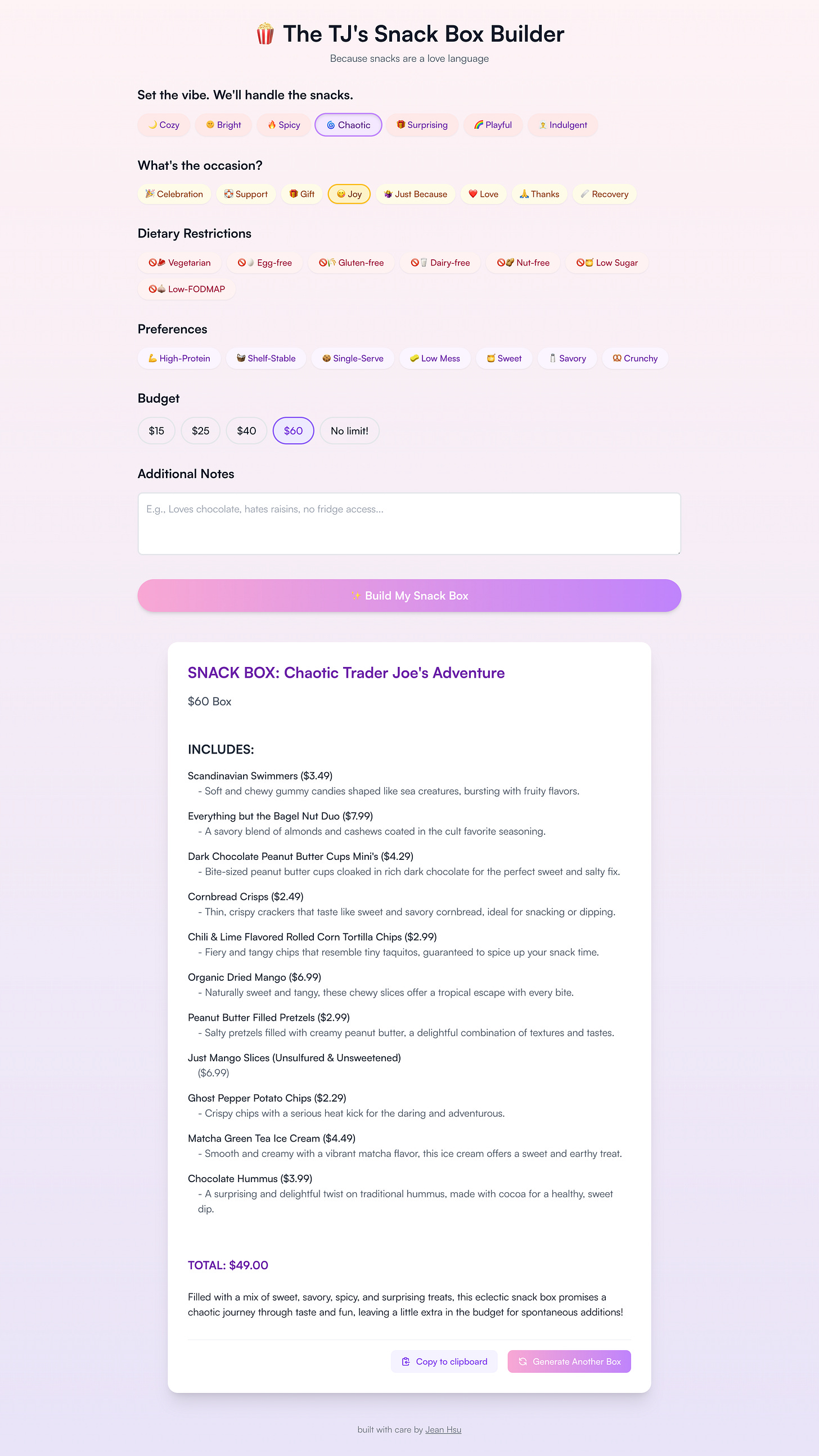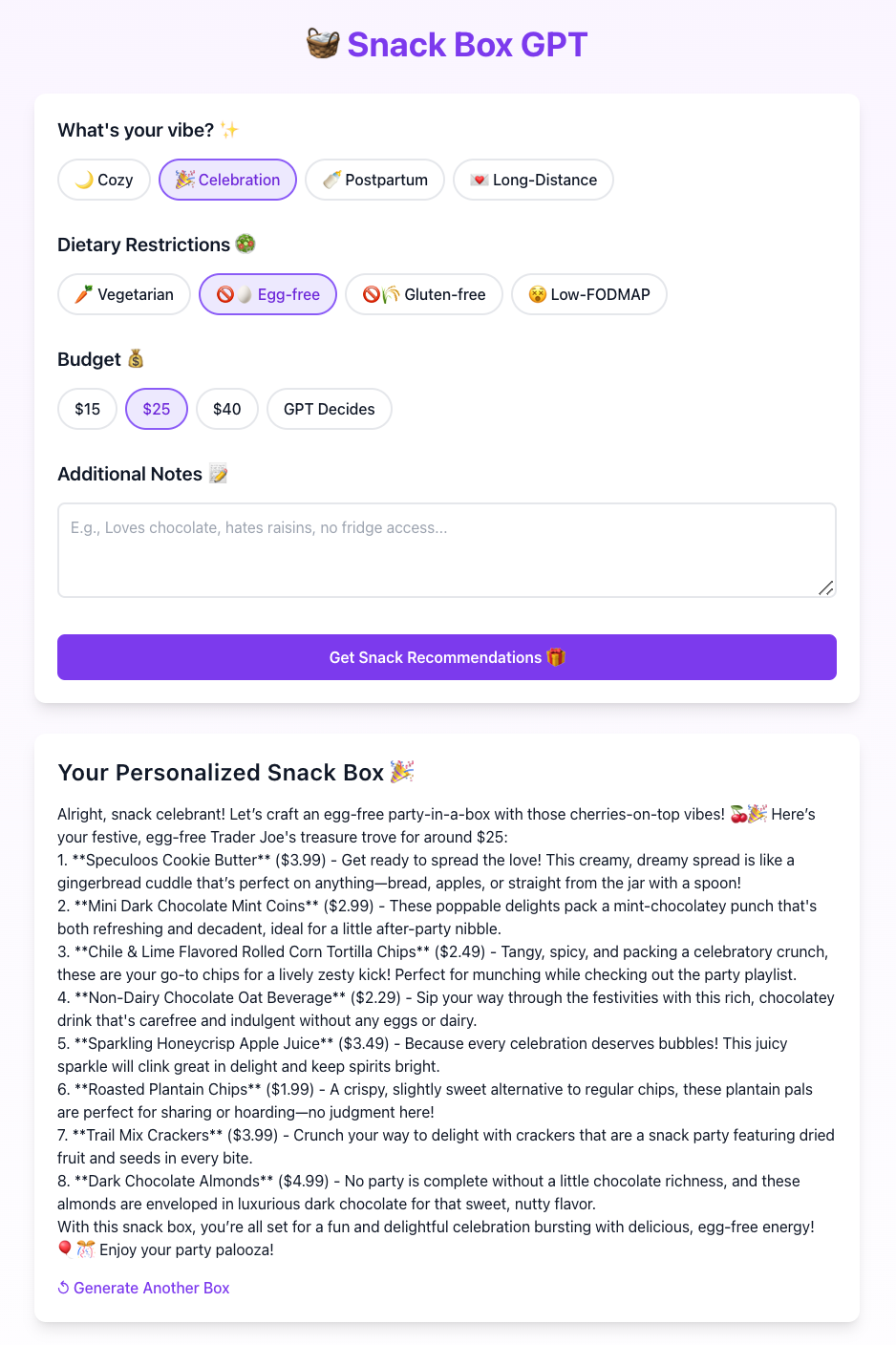My First Vibe Coding Project: The Trader Joe’s Snack Box Builder
A surprisingly delightful experience
As I’ve been using this season of exploration to write, coach, and experiment, product building has always lingered in the back of my mind.
I’m not actively running a production codebase with customers, but I’m deeply curious about how new tools are shifting what’s possible for solo builders, and also how they’re changing team dynamics, how product gets built, and the downstream pain points for engineers and engineering leaders.
I wrote more about this in my Startup Soup post, What AI Can’t Replace, but this project gave me a chance to experience the tooling shift firsthand.
I’d heard about vibe coding, or building with AI prompts without writing code yourself, but to be honest, the term made me cringe a little. I had been using Claude Code in some other projects, but more as an assistant — I was still very much in the codebase and editing lines of code.
Last week, I decided to give it a try and see what the fuss was all about, so I watched some of this Vibe Coding 101 video which was helpful just to orient myself around the different tool options, decided to download Cursor, and dove in.
A Very Silly Idea, Shipped Quickly
I wanted to start with something purely delightful and low-stakes to get over the hump of using new tools.
I asked ChatGPT to write a Product Requirements Doc (PRD) for a snack box generator, a fun little tool where you choose a vibe, add dietary restrictions, and it suggests a snack box filled with Trader Joe’s goodies. I used ChatGPT for brainstorming product ideas, then Cursor to implement, and Vercel to deploy.
I didn’t edit a single line of code by hand, unless you count my OpenAI API key I copy/pasted. I copy-pasted errors into Cursor and accepted all of its fixes and suggestions.
It was under two hours from the time I downloaded Cursor and started brainstorming different product ideas to when it was deployed to tjsnackbox.com.
The first working version was generated entirely off the ChatGPT-generated PRD.
A Surprisingly Delightful Experience
In the past, building something even as basic as this would have significant barriers, especially since I wasn’t spinning up personal projects for fun on the weekends. I’d probably get stuck choosing a stack, fumbling with local setup, diving into stack overflow rabbit holes, trying to remember which CSS framework I liked. A project had to feel “serious” to be worth doing, and anything that didn’t serve a clear goal would get deprioritized.
Vibe coding sidestepped all of that. The dev setup challenges were virtually nonexistent, I just followed the Cursor prompts. Errors were solved by copy/pasting into Cursor. I didn’t even read the code that was generated.
The experience was both delightful and occasionally frustrating. Sometimes Cursor blew away the formatting of the generated snackbox, and I had to ask it to re-style the UI multiple times. Sometimes it would fix the thing I asked and change a bunch of unrelated stuff. I didn’t bother reverting — I just kept going.

Letting Go and Looking Ahead
I had to resist the urge to turn it into a thing. As a pragmatic person, part of me wondered, should I add affiliate links? Try to make a few bucks off it? But I reminded myself that this project wasn’t about monetization. It was about unblocking myself, learning new tools, and exploring a simple use case with curiosity and delight.
As more teams adopt AI tooling and non-engineers are able to spin up prototypes quickly, discernment and pruning will become critical. Without it, companies risk ending up with a proliferation of polished but incoherent product experiments. We’ll all have to get better at letting go of things that look finished but don’t fit into a cohesive product.
After this experience, I also wonder how many AI apps will end up being just simple ChatGPT wrappers — tiny interfaces with custom UI that format a prompt and display the output. Will the average person just use ChatGPT directly? Or will there still be demand for these focused, purpose-built tools for everyday use cases like travel planning, meal prep, etc.?
There’s a lot of uncertainty in where this is headed, but trying it myself gave me a much better sense of what’s possible at this moment in time.
Advice for the Curious
I currently don’t have a production codebase with customers, so I was freed from all the usual constraints. If you’re in a similar boat, I’d recommend trying this out to any engineer who’s curious. Even if, like me, you aren’t typically a coding side project kind of person. Find the smallest use case you can imagine, and make something delightful.
Product managers and designers who are comfortable in a terminal could do this too. But keep in mind, for the sake of the engineers you work with, building a little tool from scratch is very different from shipping features inside a real, messy, legacy production codebase. So don’t get too carried away.
AI is changing how we build—rapidly. But it still has limits. Tools are getting faster and more accessible, but discernment, strategy, and human taste still matter. I shared more thoughts on that in my Startup Soup post, What AI Can’t Replace, if you’re interested in the broader team-level implications.
I would love to hear how AI has changed (or not changed) your day-to-day? Leave a comment!






very cool post. as a trader joe's fan, i approve the vibe coding project!
also, appreciated how you kept this as play instead of trying to turn it into a hustle. "I had to resist the urge to turn it into a thing. As a pragmatic person, part of me wondered, should I add affiliate links? Try to make a few bucks off it? But I reminded myself that this project wasn’t about monetization. It was about unblocking myself, learning new tools, and exploring a simple use case with curiosity and delight."
2 hours from zero to MVP is pretty awesome!